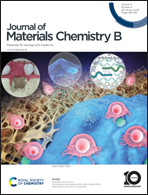Integration of genetically engineered virus nanofibers and fibrin to form injectable fibrous neuron-rich hydrogels and enable neural differentiation†
Abstract
Peripheral nerve injury (PNI) results in persistent pain, a burning sensation, tingling, or complete loss of sensation. Treating large nerve defects is a major challenge, and the use of autologous nerve grafts (ANGs) cannot overcome this challenge. Hence, substitutes for ANGs that can serve as artificial nerve fibers are urgently needed in the clinical treatment of PNI. To develop such substitutes, we genetically engineered a virus nanofiber (M13 phage) that displays a high density of RGD peptide on its sidewall, producing an RGD-displaying phage (R-phage). In the presence of neural stem cells (NSCs), the resultant negatively charged R-phage nanofibers were electrostatically bound to a complex (with a net positive charge) of negatively charged fibrin and positively charged polyethyleneimine (PEI). The biocompatible injectable fibrin gel (FG) was integrated with R-phage and seeded with NSCs, forming a hydrogel termed R-phage/FG, which is further extruded through a syringe to form a fiber. The developed fiber-shaped hydrogel exhibited the desired excellent physical–chemical properties, and controllable and appropriate mechanical properties (170–240 kPa) similar to native nerve. The R-phage/FG not only promoted NSC adhesion, infiltration, and proliferation, but also induced efficient preferential differentiation of NSCs into neurons in the hydrogels in a non-differentiating medium within only 4 days. After the NSC-seeded R-phage/FG was injected into the long-gap (10 mm) defect of a rat's sciatic nerve, a solid neuron-rich hydrogel fiber was formed as an artificial nerve fiber graft that stimulated neurogenesis in the transplanted area within 60 days for nerve regeneration. These results suggest that the R-phage/FG fiber represents a potential substitute ANG for repairing large nerve injuries. This work demonstrates a new phage-based biomaterial that can be used as a graft for treating PNI through neurogenesis.



 Please wait while we load your content...
Please wait while we load your content...